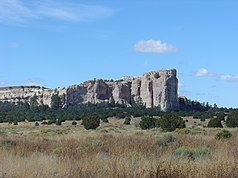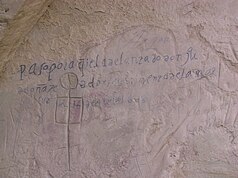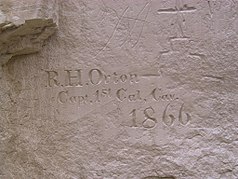El Morro National Monument
| El Morro National Monument | ||
|---|---|---|
| View of the Inscription Rock | ||
|
|
||
| Location: | New Mexico , United States | |
| Next city: | Ramah (New Mexico) | |
| Surface: | 4.2 km² | |
| Founding: | December 8, 1906 | |
| Visitors: | 65,233 (2004) | |
| Inscription by Don Juan de Oñate from 1605 | ||
| Inscription by P. Gilmer Breckinridge from 1859 | ||
| Inscription by RH Orton from 1866 | ||
El Morro National Monument is a US national monument and is located about 200 kilometers west of Albuquerque in the northwest of the US state New Mexico . The central element of the national monument is the Inscription Rock , a gigantic rock formation that catches the eye from afar in the otherwise very flat desert landscape. The name is also derived from this: in Spanish, morro is a prominent rock that serves as an orientation point.
Thanks to this fact and a natural pool of water at its base, El Morro has for centuries made all kinds of travelers rest in its shadow or set up camp for the night. Over the past centuries, more than 2,000 travelers have engraved their names, dates, or stories on the sandstone of Inscription Rock in an effort to bear witness to their presence .
The Zuñi people , the direct descendants of the Anasazi, call the rock massif A'ts'ina ( place of rock inscriptions ), the Spaniards El Morro ( headland ), the Americans finally coined the name Inscription Rock . The unifying element of these groups is that they have all left engraved traces of their presence (carvings) on the flanks of the rock.
history
The Inscription Rock in El Morro National Monument is geographically located on an east-west axis that has been established for centuries through what is now New Mexico.
The Anasazi began to settle down about 2000 years ago , and over time the first settlements appeared in this area. The remains of these settlements are still scattered across the American Southwest. Remains of settlements of this culture can also be found on the plateau of El Morro National Monument. Long before Europeans first reached this area, the Native Americans had already started to make rock drawings ( petroglyphs ) in the area of what is now the national monument.
The first evidence of a European in the El Morro National Monument is the inscription of the Spanish conquistador Don Juan de Oñate from 1605 : Pasó por a [qu] í, el adelantado Don J [ua] n de Oñate del descubrimiento de la mar del sur a 16 de Abril de 1605 (analogously: Don Juan de Oñate passed here on a South Seas expedition on April 16, 1605 ).
But the story of the inscriptions on Inscription Rock had only just begun. More than two centuries later, in 1849, James H. Simpson and Richard Kern visited Inscription Rock as part of an army expedition to the area . They were so impressed by the inscriptions that were already there that they spent two full days copying and archiving them. Simpson's account and Kern's drawings were the first written mentions of the rock. The so-called El Morro Route was soon a well-known route to California for settlers . Over the next few decades, American travelers stopped at El Morro with increasing frequency. These included settlers, researchers, military personnel, and an advance command of the Union Pacific Railroad .
A special episode is the visit of P. Gilmer Breckinridge, Henry C. Wayne and Edward F. Beale in 1859. In an attempt to solve the problem of the water shortage on the way between the states of Mississippi and California , they had bought numerous camels on behalf of the US Army in Egypt and Turkey . With these they wanted to prove that the use of camels in the southwest of the USA had clear advantages over the use of the usual draft animals. When the trail arrived in Los Angeles in December of this year , it caused a tumultuous sensation. With the outbreak of the American Civil War , however, this chapter of American history also came to an end.
The national monument
On December 8, 1906 , the Inscription Rock and a surrounding area of around 486 hectares was declared a national monument by President Theodore Roosevelt at the same time as Montezuma Castle in Arizona . Since then it has been forbidden by federal law to put inscriptions on rocks within the area. However, the National Park Service has had a small rock attached to the entrance to the visitor center on which this is expressly permitted.
Pueblo Atsinna
On the flat surface of the Inscription Rock lies the only partially exposed Pueblo Atsinna. The history of the settlement begins around 400, as evidenced by pit houses nearby. Around 1250, smaller settlements were created on the rock, presumably because residents of the region moved to higher parts because of the worsening climatic conditions, where heavier precipitation was to be expected. Atsinna came into being when the smaller pueblos were abandoned in favor of Atsinna after 1275. Atsinna consisted of two concentric squares with a total of more than 500 rooms around a large central courtyard. Since there were no external entrances, the only way to get into the pueblo was by ladders. During the archaeological investigations by Richard B. Woodbury around 1950, a complex water supply was identified, which was fed by natural rock depressions and artificial retention basins. Soon after 1300, Atsinna was also abandoned and its residents moved to their earlier settlements near Zuni.
literature
- David Grant Noble: Ancient Ruins of the Southwest, an archaeological guide . Northland 1996. ISBN 0-87358-530-5 (pp. 113-116)
Web links
- National Park Service: El Morro National Monument (official site; English)






